The cult of celebrity does not exist in Finland. The country has produced more motor racing successes per capita than anywhere else in the world, but this is met with the same calm reservation with which Finns seem to regard everything. There is after all a famous Finnish proverb that translates: “Praise your horse tomorrow . . . and yourself never.”

Underneath the stoic exterior, though, is a resilient and resolutely independent streak. Having maintained their borders ferociously during the Second World War, Finns later stood between the forces of the Soviet Union and NATO’s northern flank, keeping up relations with both Moscow and the West throughout, while yielding to neither in terms of borders or sovereignty.
Unsurprisingly, the Finnish Border Guard (Rajavartiolaitos) enjoys a strong reputation among its own population. However, as a small organization it is required to turn its hand to a variety of tasks. While the Border Guard maintains specialist units on land and at sea, it is its Air Patrol Squadron that most demonstrates this flexibility, given the squadron’s ability to cross both land and sea with relative ease.
Ice and fire
As a paramilitary force, the Border Guard falls under the authority of the Finnish Ministry of the Interior and is responsible for internal security. However, the Air Patrol Squadron also provides search-and-rescue (SAR) cover both within Finland and for its roughly 28,500-mile (46,000-kilometer) coastline. Much of its work involves assisting seafarers of all kinds who find themselves in difficulty, either in the busy shipping lanes of the Baltic or the frigid Gulf of Bothnia, which is covered in ice for up to five months of the year. Onshore, vast swathes of unspoiled taiga, or boreal forest, provide an environment in which it is just as easy for those who prefer ski-trekking or hiking to find themselves in trouble.

The density of the forests poses other risks. Lightning strikes can ignite forest blazes that would quickly become firestorms among the tightly packed pines, making rapid intervention essential but possible only from the air, due to the degree of isolation. The last truly large-scale conflagration was in 1960 and engulfed over 6,000 acres (2,430 hectares). Since then, control measures seem to have reduced the scale of forest fires, but with no way of preventing lightning, their frequency has remained stable. Using underslung SEI Industries Bambi Buckets to deliver water and retardant early on in a fire’s life, the Air Patrol Squadron is a key factor in ensuring that fires don’t spread out of control.
“Search-and-rescue at sea is our major duty, that’s the one that is written in [international] law that we must do,” said Roope Kauhanen, an Airbus H215 captain and head of training at the Border Guard’s Helsinki base. “Of course, the police and fire department don’t have their own air assets, so we must help them, too.”
The Air Patrol Squadron has a long history stretching back as far as the ’30s when the unit flew Junkers F.13s — the world’s first all-metal cargo aircraft. Since then, the squadron has operated a mixture of Western and Eastern Bloc designs of fixed- and rotary-wing aircraft, ranging from de Havilland Canada DHC-2 Beavers (only retired in 1985), to Mil Mi-1s and Mi-17s that gradually gave way to Eurocopter (now Airbus Helicopters) AS332 L1 Super Pumas and Agusta/Bell (AB) 206 JetRangers and 412s.
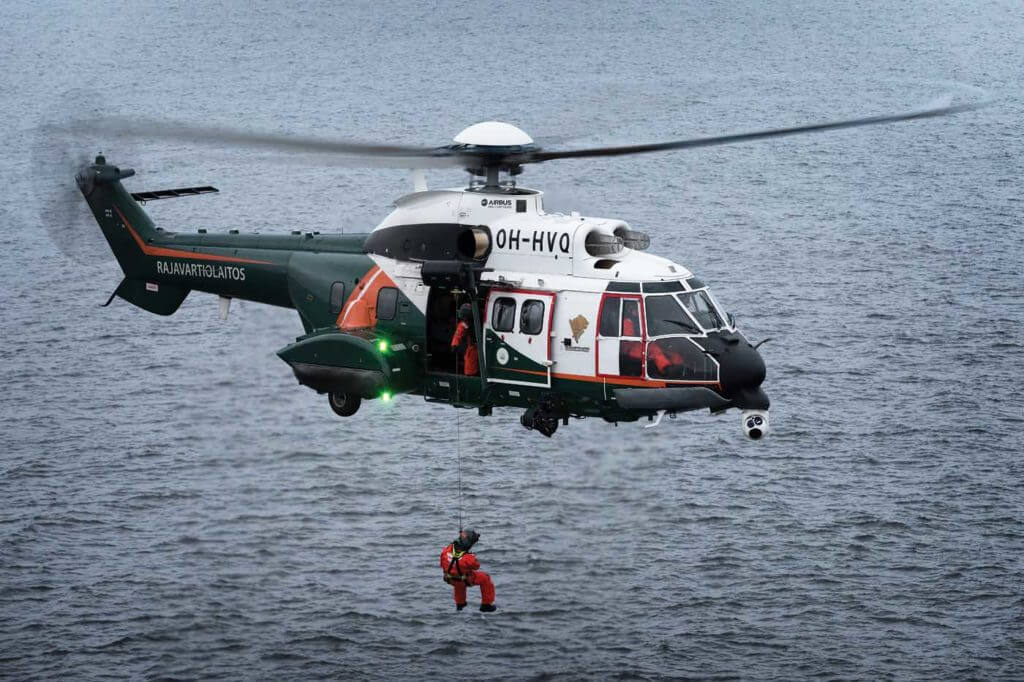
While the Border Guard has maintained its AS332 L1s, the Air Patrol Squadron now operates a modern mixed fleet of helicopters. This includes four Leonardo AW119Ke Koalas and two Airbus H215s (formerly known as the AS332 L2), as well as a selection of AB 412s and 412EPs, two of which will continue in service after an upgrade program courtesy of Patria that will modernize their avionics and surveillance systems.
Holding the line
Since 1995, Finland has been a member of the European Union (EU) and shares its Western border with Sweden and Norway, with all three being Schengen states: European nations across which common domestic policy renders strict border control unnecessary, allowing the Border Guard to focus its aerial patrols along the eastern boundary.
Finland has maintained functioning border-crossing agreements with Russia, but it has still proven necessary to patrol this frontier to deter and prevent illegal entry by immigrants, many of whom have made a long and unpleasant journey from unspeakable horrors in their home country courtesy of criminal organizations with scant regard for their well-being.
The vast tundra border is most effectively patrolled from the air, a role mainly performed by Air Patrol Squadron’s Koalas. The single-engine design provides a good compromise between performance, endurance and efficiency, and its skids are undoubtedly better suited to the environment than a retractable wheeled undercarriage. The Koalas also provide a platform on which the newer pilots and flight engineers can cut their teeth before progressing onto more complex multi-engine machines.

Illegal immigration is a felony in Finland, but the Border Guard’s patrols do more than simply uphold the law — they also demonstrate the ability to scale up the tempo of operations, lest Finnish forbearance be mistaken as an opportunity for the country’s Eastern neighbor to exert strategic influence. Such an opportunity was explored in the winter of 2015-16, when Russia inexplicably abandoned a decades-old understanding and began allowing third-country nationals access to the border to seek asylum in Finland.
Elsewhere, the Border Guard carries out security activities across the country, both to deal with niche internal smuggling such as the illicit trade in snus (a kind of tobacco snuff that is only legal to produce in neighboring Sweden) but also countering far more sinister threats.
“More and more the world is seeing an increase in terrorism, so we have to train with the police and our own task force for those kinds of operations,” said Kauhanen. By “task force,” Kauhanen was referring to the Border Guard’s 5th Special Intervention Unit, a highly trained commando group that was established to ensure that Finland was prepared to meet any threats that emerged from the tinder box of lawlessness that followed the collapse of the Soviet Union. The role of this commando group has since evolved, and the Air Patrol Squadron now trains to support it with a variety of techniques — such as fast-rope insertion — that have proven utility in counter-terrorism scenarios.
Great compromise
Fulfilling such a wide variety of missions demands a correspondingly broad spectrum of capabilities that must be delivered under the most extreme environmental duress. Finland’s largest and northernmost region of Lapland has a population density of fewer than two people every square kilometer; that’s sparser than Wyoming. When Vertical 911 visited the Air Patrol Squadron base near the regional capital of Roveniemi, the ambient temperature was -34 C (-30 F), so both the aircraft and their crews need to be particularly resilient to operate here. At a latitude of more than 66 degrees north, the sun barely sets in summer, and the winters are perpetual darkness.
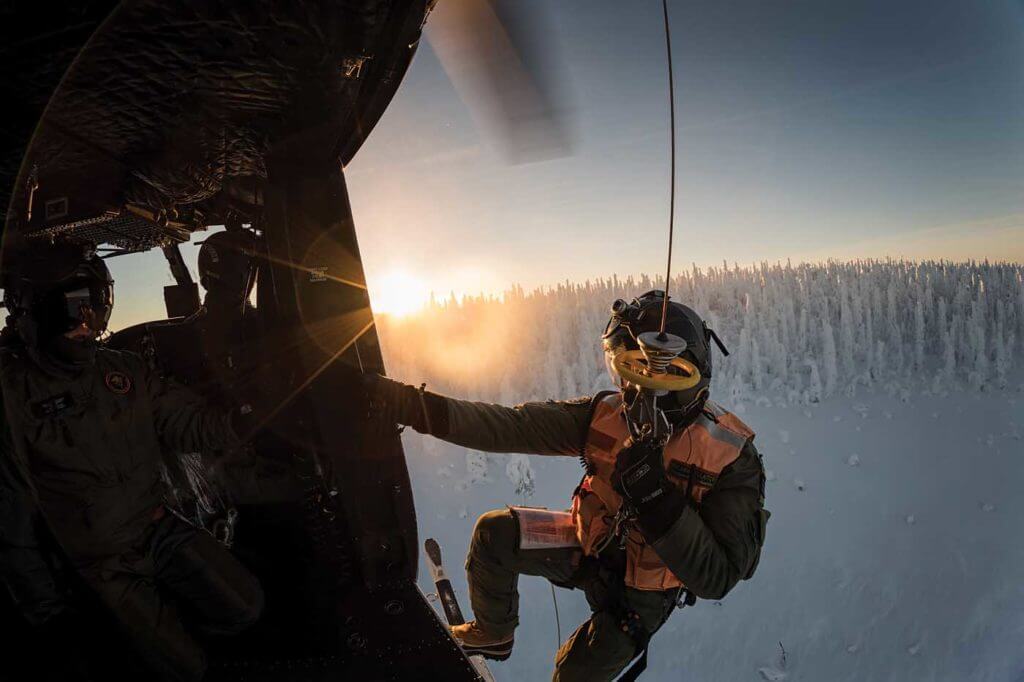
Simplicity is a real virtue in these conditions, and that is a key benefit of the Border Guard’s AB412s and Koalas. Aviation being a game of compromises, these aircraft provide a good trade-off between capability, robustness and ease of maintenance. They are also relatively small, producing less downwash and much more manageable re-circulation — air being pulled around and around through the rotor disc, picking up snow into a whirling vortex that obscures the pilot’s visibility. This can cause lethal disorientation during take-off and landing, particularly over low-contrast terrain with an indistinct horizon. The lighter the aircraft, the less pronounced this effect, but for all their virtues these smaller helicopters lack any form of airframe anti-icing system, which brings its own complications.
“It’s always an issue in nighttime or with low clouds in winter,” said Kauhanen. “With the 412 you have to go low, mind your step, and look out for all the obstacles like power lines and trees.”
In this climate, the cloud can be just as deadly as the terrain. Unwary instrument flight rules (IFR)-rated pilots thinking that their “get out” option is up into the freezing murk, can quickly find that their instrument flying safety net has become an icy noose.
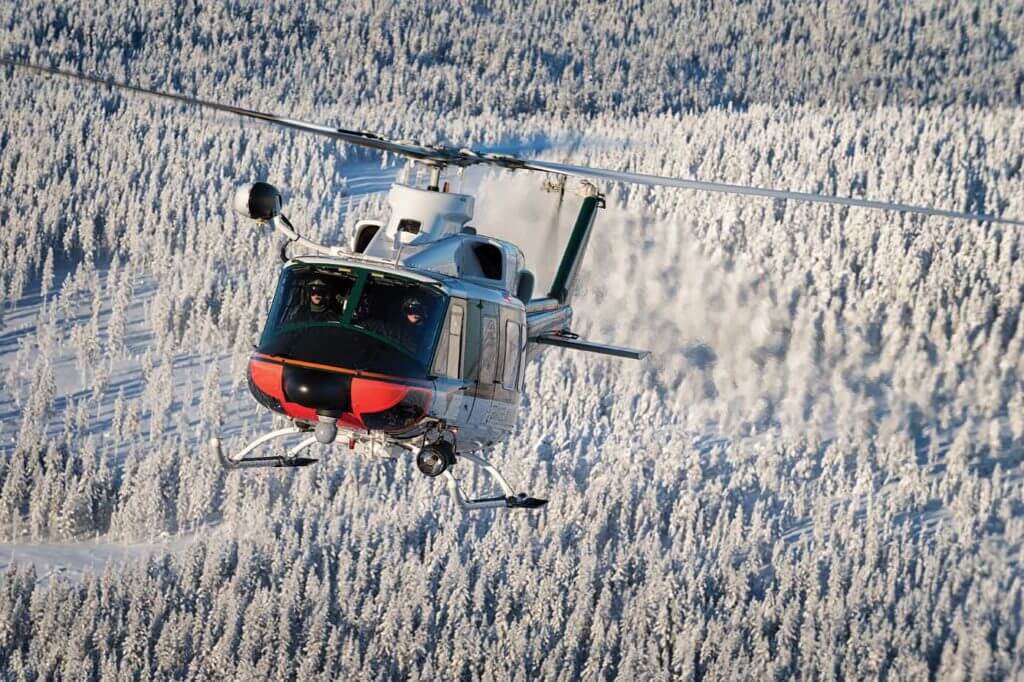
Kauhanen recalls flying the 412 in the offshore SAR role, which is now the sole preserve of the H215s. “We flew all the same profiles that we do now, but if the weather was bad enough and there was icing, we had occasions where we couldn’t even take off. I think our mission profile now is safer. We can go up where there are no obstacles, and then down to the sea area.”
Both H215s are operated from Helsinki, with practically tropical average temperatures just above freezing. These much larger and more complex aircraft are the Air Patrol Squadron’s new workhorses, received from Airbus in 2016 and specified to be capable of every mission that might be demanded of them.
Since the principal role of the H215s is offshore SAR, they are equipped with Air Ambulance Technology’s Medical Wall, which functions as an oxygen panel and is equipped with patient monitors and defibrillator, ventilation and suction, as well as a perfusion pump, which acts as an alternative to cold storage for transplant organs.
The avionics are supplemented with the maritime Automatic Identification System, which tracks shipping globally, as well as a 406MHz radio homing system. Externally, the L-3 Wescam MX-15 HDi multi-mode camera and Boeing Spectrolab Nightsun SX-16 searchlight are equally suited to SAR, border security and intervention missions; whereas the lateral fast-roping support beam is more single-mission focused.
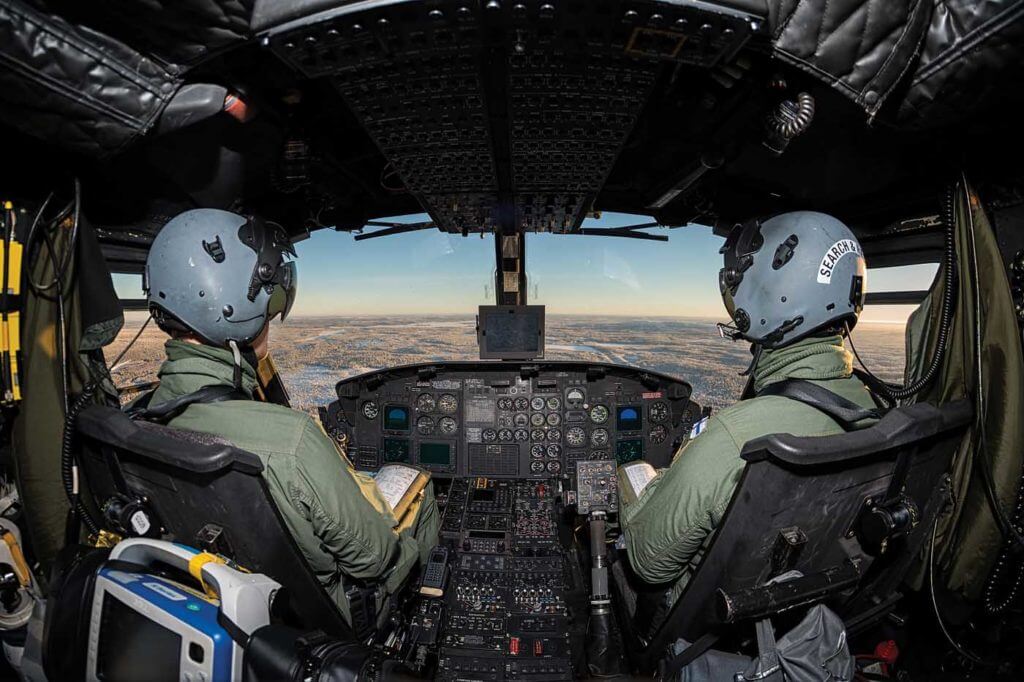
The H215s are fully IFR-capable, equipped with full de-icing and Airbus Helicopters’ renowned four-axis autopilot — a welcome addition for their pilots, as Kauhanen explained. “With the 412, we flew 90 percent by hand and 10 percent using the automation. With the 215 it is vice versa. The automation is fast, easy to use and it is much more accurate than you can ever be by hand.”
This too, however, comes with caveats. “It is also challenging for the pilot, because you have to understand the philosophy of the automation and its laws. If the aircraft has a failure you need to know what it is going to do,” Kauhanen noted.
The H215 is undoubtedly a step up from the venerable AB412, but there are evidently still compromises. Even with all this capability, it is still down to a human being to play to the aircraft’s strengths and navigate through the limitations to achieve the mission, which demands extreme proficiency.
The human elements
While maintaining this proficiency among trained crews is an obvious challenge, so too is providing them with the necessary expertise to operate in such complex roles early on in their career, especially considering that Finland does not have a large military from which to draw experienced personnel. The Air Patrol Squadron is therefore faced with the corollary challenge of sustaining sufficient throughput of personnel to allow steady progression on to more complex types.

Careers for flight mechanics and pilots begin at the National Defense University, which the pilots join after their conscription service as flight students. Professional training for both then revolves around attaining the civil licenses necessary to operate: for flight mechanics, an EASA Part-66 license; and in the pilots’ case, a Commercial Pilot License (CPL) for which training is contracted to Northern Helicopters of Sweden, operating the Guimbal Cabri G2 and Airbus EC120. Rescue swimmers are recruited and trained internally, with an emphasis on prior diving or rescue training, and many become flight paramedics as a parallel qualification.
Once qualified, personnel are posted to Border Guard units to begin specialist training before flying operational sorties. Flight mechanics will serve a couple of years conducting maintenance before being qualified to fly as crew. Alongside the pilots, their first type is usually the Koala, in which they will build their experience as part of a two-man crew before transitioning to more complex types. For pilots, the route from elementary training to commanding one of the larger helicopters can be as long as 10 years.
Multi-engine helicopters have a crew of four, or five in the case of the H215: two pilots, a flight mechanic acting as hoist and systems operator, and one or two rescue swimmers whose job ultimately involves leaving the relative safety of the aircraft to deal with whatever emergency is unfolding at the scene of the rescue. For this they are equipped with the necessary diving gear, but with an understandable emphasis on protection against the cold; the average sea temperature around Finland is around 6 C (43 F). The Border Guard also draws on its long-established ethos of close cooperation with other civil and public bodies and services, frequently flying with doctors from FinnHEMS (the national helicopter emergency medical services provider) as well as divers from the fire department or police officers.

Once the crews are qualified, there is little respite from the training regime, as rescue swimmer Sami Ollila explained. “Typically, the on-duty crew performs a training flight during shift, depending on the needs of each individual and the environment. During fall, night training is a priority for example and in spring we have to prepare for fires by training with the Bambi Bucket. Rescue swimmers and flight mechanics also conduct firearms training,” Ollila said.
Rescue swimmers are also required to keep themselves in good physical shape, as while the job of the pilots can be cognitively demanding, those descending to the scene are often placed in the most physical danger. Kauhanen described how missions that are demanding for one profession are often easier tasks for others: “If you have a big sea state but a steady wind, it’s easy to hover and put the rescue swimmer down. But he’s in trouble.” (There is a sense here of Finnish humility, as there are plenty of times when, low on fuel and in rough seas, things can be just as tough for the pilots.)
Faced with such a broad number of tasks and required to perform them in conditions that would challenge many simply to survive, the Border Guard are very selective about their people. As Kauhanen put it: “I don’t know any other operators that do so many different roles as we do, and of course if you want to work at a professional level, you have to train a lot.”

The environment and the missions clearly push the aircraft of the Air Patrol Squadron to the edge of their means. An aircraft perfectly tailored to this kind of operation does not exist and arguably is beyond design, at least within a conceivable budget. The helicopters, with all their intrinsic compromises, provide only the potential. It is through the proficiency of their operators that this potential becomes capability.
Maintaining these high levels of competency is of critical importance, not only to those who call upon them for help among the Arctic wilderness or out to sea, but also to their nation as a whole. While the Air Patrol Squadron’s core mission is to detect and deter illicit border crossings, it is also to demonstrate the quiet confidence and capability that forms a fundamental part of the Finnish character, to whomever may be watching.





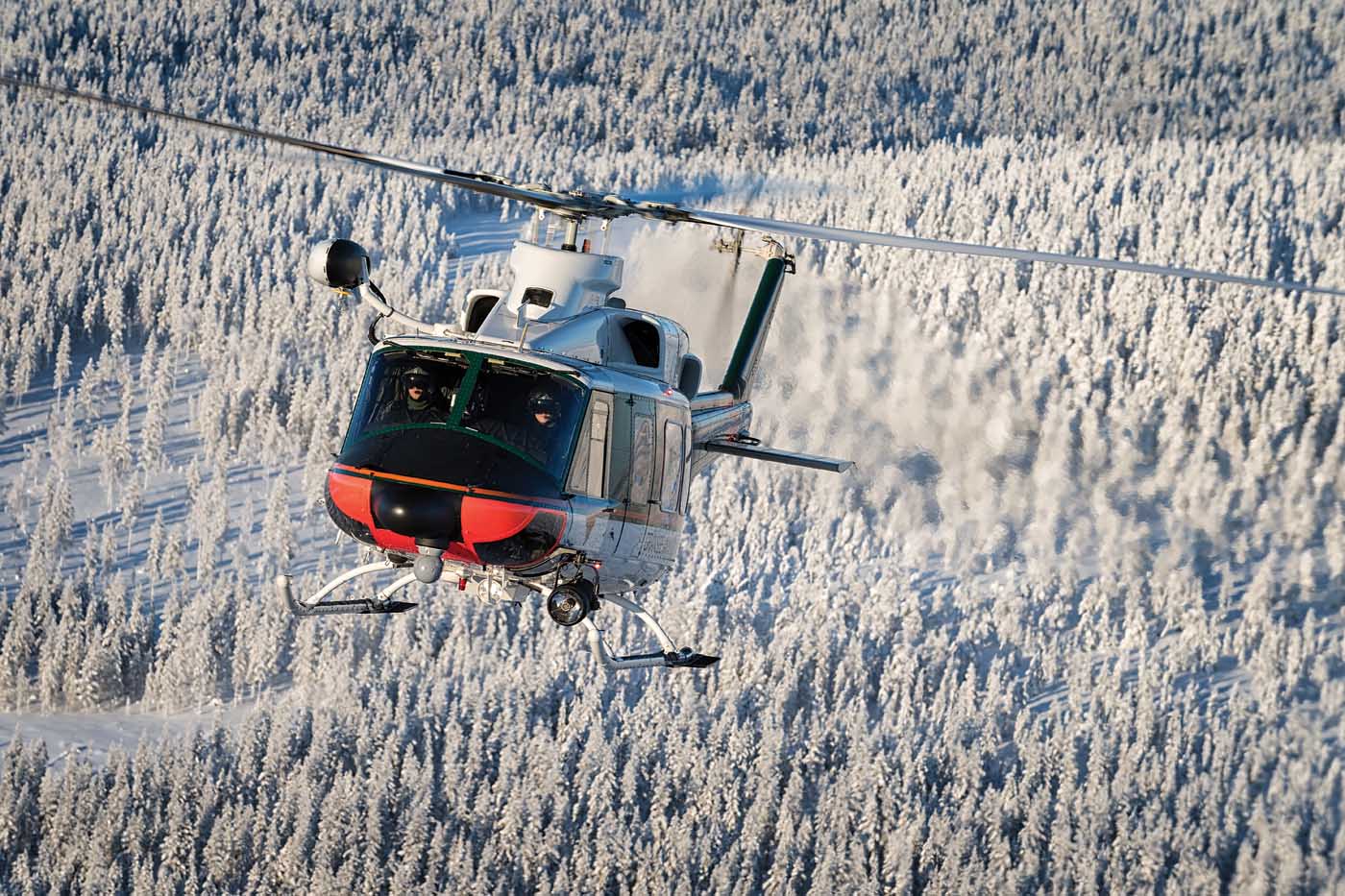
Sorry but it is H225 and not H125 on those pictures…
Thanks for catching the captioning error – we’ve made the correction now. It’s actually an H215 – but certainly a lot closer to an H225 than an H125 in looks!